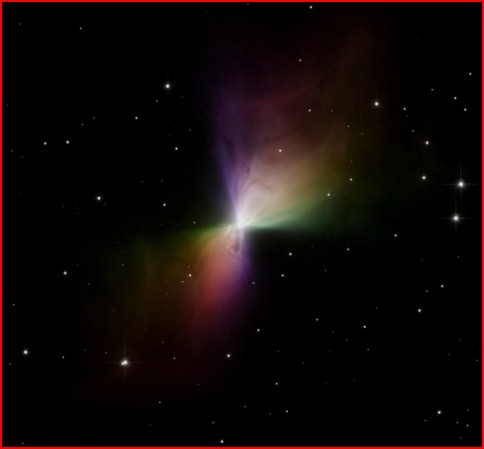
home •
about •
essential guide •
picture of the day •
thunderblogs •
news •
multimedia •
predictions •
products •
get involved •
contact
picture of the day archive subject index
Credit: NASA, ESA and The Hubble Heritage Team (STScI/AURA).Jul 05, 2006
Boomerang Nebula Comes Back—to PlasmaA cold nebula provides evidence of electrical activity at temperatures near absolute zero.
The Boomerang Nebula exhibits the bipolar symmetry that has become typical of planetary nebulae: two cones or, often, bubbles of material radiate away from the central star (which is often a double star). In most nebulae, the plasma is sufficiently dense and excited to emit light. But the Boomerang Nebula is cold: Radio measurements indicate the inner part is only one degree above absolute zero. We are able to see the nebula because dust particles reflect light from the central star.
In this image from the Hubble Space Telescope, the false colors indicate polarization angles of the reflected light. By analyzing how the light from different parts of the nebula are polarized, astronomers can determine such properties as the size and alignment of the dust particles. They hope that this information will shed light on the most pressing question: How can a spherical star, powered internally by nuclear fusion, eject material only along its axis? If only gravity and hot gas provide the forces for ejection, the ejection should be spherical.
Some theorists speculate that perhaps a disk of material around the star’s equator—seen in a number of nebulae—blocks ejected material from that direction. But what generated the disk, and how does it remain intact in the face of such ejection? Other theorists speculate that magnetic fields constrain the outflow. But what generates and powers the magnetic field?
The Electric Universe takes note of the filamentary structure of the cones and of the way the filaments spiral into and away from the central star. It also takes note of the string of cells or bubbles along the axis of the cones. Spiraling filaments around cells of plasma are the forms taken by electric currents in space. The filaments are called Birkeland currents, named after Kristian Birkeland, who first proposed their existence in the late 1800s.
Far from a star, these currents form tubes of plasma that transmit electrical power around a galaxy. At intervals, the electromagnetic forces that they generate cause them to pinch down to a very much smaller size. Plasma accumulates in the center of the pinch. The increased current density causes it to shine, producing and powering a star. Usually, the plasma surrounding the star is also hot, producing the glow of an emission nebula. But with the proper conditions of opacity and density, the surrounding plasma can be cold, as in the Boomerang Nebula, revealing its presence only by reflected light and radio emission.
Plasma theorists would not be surprised if closer observations discover a disk of material around the star’s equator. In lab experiments and in computer simulations of the pinch effect, a “ring current”—a doughnut-shaped flow of plasma and electricity—circles the central accumulation of plasma. Power flows into the ring current, which stores it until a threshold is reached. Then the ring discharges to the central body.
But the ring doesn’t block an equatorial outflow: The magnetic field generated by the pinched-down Birkeland current that powers the star confines the flow of plasma from the star into the axial jets.
The gravitational theorists have guessed the forms, but they still have no explanation why the forms are there.
___________________________________________________________________________Please visit our Forum
The Electric Sky and The Electric Universe available now!

|
|

|
EXECUTIVE EDITORS:
David Talbott, Wallace Thornhill
MANAGING EDITORS:
Steve Smith, Mel Acheson
CONTRIBUTING EDITORS: Dwardu Cardona, Ev Cochrane,
C.J. Ransom, Don Scott, Rens van der Sluijs, Ian Tresman
WEBMASTER: Brian Talbott
Copyright 2006: thunderbolts.info
![]()
home •
thunderblogs •
forum •
picture of the day •
resources •
team •
updates •
contact us

